| Columns Retired Columns & Blogs |
Thanks for such an informative review. But is this cable brand still iin business since you mentioned the company is no longer in existance. Are they availabel for purchasing?
Back in the February issue (Vol.14 No.2, p.158), young Dick Olsher, Stereophile's resident physicist, gave a rave review to interconnect from a new California company, Lindsay-Geyer. Their model 4-40 is different from every other interconnect in that it is constructed from a magnetically permeable material, namely "Mu-metal." (Four individually insulated 40-mil strands are used.) Normally such a material is avoided for conducting signals, due to its low conductivity. (The fact that it is permeable means that the current is squeezed into a shallow skin around the circumference, even at audio frequencies, thus increasing its resistivity.)
Why, then, would having a permeable conductor be an advantage?
In Dick's review, he paraphrased Lindsay-Geyer's white paper to explain that while the signal's electromagnetic wave propagates along an ordinary conductor at a velocity approaching that of light, "the signal sinks into the wire as an inverse function of frequency (the skin effect). The magnitude of [this current] decreases exponentially with depth of penetration because of ohmic losses. At each frequency, a skin depth may be calculated at which the attenuation is exactly 1/e, or 36.8%. The signal is also retarded in phase as it sinks into the wire because of the finite velocity of propagation [of a current] inside the wire...In copper at 1kHz, the [current] speed is a relatively pedestrian 13m/s. At that speed, a signal will sink through a 1mm wire in 77 microseconds. A 77µs delay should clearly be audible, assuming the magnitude of the delayed signal is significant—which is the case here. The skin depth at 1kHz is 2.1mm in copper, so the magnitude of the re-emergent signal for a 1mm wire is only down about 4dB."
Note that DO is not talking about the EM wave that carries the signal information, but about the associated current at a direction of 90° to the conductor axis. His point is that textbook electronics theory—see Engineering Electromagnetics, by William H. Hayt, McGraw-Hill, pp.398–402, for example—appears to indicate that the initial wave propagating along the cable will be followed by a delayed version reduced in level due to the attenuated 90° current reemerging after passing through the cable thickness. (Imagine a circle at the cable surface collapsing evenly through the conductor to a point at its center, then re-expanding back to a circle at the surface, all the while diminishing in intensity by a factor of 1/e for every skin depth.) That is, in fact, if the re-emergent current is itself associated with an electromagnetic wavefront. If it is, then although each slice of the conductor will presumably give rise to its own echo, because the speed of the EM wave is so much higher than the current speed, the effect at the end of the cable will still be of a single echo.
"Let's consider what happens to a transient waveform propagating down this 1mm copper wire," continued DO in his review. "Because the waveform is composed of many harmonics and because the 'sinking speed' is a function of frequency, a transient that sinks through the wire will be smeared out in time. The typical [copper] interconnect then propagates the original signal plus a smeared-out copy of that signal. It is possible for the smeared copy to sink through the wire again and generate another smeared copy of itself."
In other words, Lindsay-Geyer claims that using a conventional conductor such as copper will result in progressively attenuated "echoes" smearing the musical information. But by making the conductor permeable—a topology patented by Dr. David Lindsay—the skin depth will be made so small that the delayed current will be totally attenuated, the result being an absence of any such smearing, to the benefit of the music. And DO did find that the L-G interconnect was eminently musical, its sound quality, he wrote, "founded on three cornerstones: treble purity, harmonic integrity, and image cohesiveness."
The obvious correlation to draw is that between the L-G's sonic performance and its supposed absence of signal smearing. Or is it? I must point out that I regard all this talk of echoes and transient smearing as conjecture. If such an effect did exist in conventional copper conductors at audio frequencies—at radio frequencies, echoes galore occur every time there is an impedance mismatch between source, cable, and receiver—then surely someone would have noticed? I therefore decided to set up a simple experiment to look for the presence of the Lindsay-Geyer effect.
To hand was not only a 6m length of Lindsay-Geyer interconnect, but 8m of twisted-pair, solid-copper, single-conductor R232 data cable, this having a conductor diameter of 0.6mm, giving an "echo" time of 46µs for a 1kHz signal. I also had available a 5m length of a high-performance commercial interconnect, AudioQuest Lapis. At 2800pF, the measured capacitance of the L-G cable was much higher than that of either of the other two cables. (The Lapis measured 650pF, the solid-core copper 500pF.)
Cable capacitance will only be a factor if the source driving the cables offers a high output impedance. The frequency at which the system's response is down 3dB can be calculated by the formula f = 1/(2PiRC) (where C is in farads, R in ohms). With a 1k ohm source impedance, typical of the worst case when it comes to high-end tube and solid-state preamplifiers, the response will be down 3dB at 245kHz with Lapis, at 318kHz with solid-core copper, and at 57kHz with Lindsay-Geyer. All of these frequencies are above the audio band, of course, but the L-G is a little close for comfort. With a significantly higher source impedance, such as that offered by a typical passive control unit, the high frequencies will be rolled-off by this length of L-G cable. The Mod Squad's Line Drive, for example, has a maximum output impedance of 2050 ohms with the volume control set at 2 o'clock, which will give a –3dB point at 27.7kHz with L-G, the result being audibly dulled high frequencies.
But echoes and transient smearing are the order of the day's experiment. Lindsay-Geyer's putative time-smearing is frequency-dependent in that low frequencies produce more separated, less attenuated echoes than high frequencies. It would seem appropriate, therefore, to use a single-frequency sinewave which would suffer a discrete echo. However, to look for the presence of such echoes with a sinewave wouldn't be very informative as the human ear-brain is very poor at detecting echoes with continuous waveforms. Audio-frequency echoes would also occur very close to the stimulus waveform, and therefore would be very hard to detect with a 'scope. No, as the ear-brain is superb at detecting echoes with transient stimuli, I would choose pulses as my test signal and assume that though the constituent frequencies in the pulse would suffer varying delays, an echo effect of the strength suggested by L-G would still make its presence known. I used DRA Labs' MLSSA system to generate repeated unipolar rectangular pulses (footnote 1) which I then fed through the cable under test to a Heath 8-bit digital storage 'scope. (Although the MLSSA incorporates a 12-bit 'scope, this has a built-in anti-aliasing filter which could confuse things. It also cannot cope with input peaks that would saturate its ADC.) To capture the pulse shape centered around the 0V axis, I used the 'scope's AC input connection; its input impedance was 1M ohm.
For the first experiment, I used an impulse of some 7V peak amplitude and 19µs length fed to the 'scope via the solid-core copper cable. This can be seen as the top trace in fig.1, which features two such pulses. The impulse tail between the pulses features a degree of noise, probably due to the unshielded cable picking up some RF hash from the computers in Stereophile's lab. Expanding the vertical sensitivity by a factor of 20 gives the lower trace in fig.1. (Ignore the clipped top and bottom of the waveform; this is due to the signal exceeding the ADC's dynamic range capability.) Because the LSB was still toggling a little on this magnified trace, I averaged 32 such samples, so that the noise would fall away, allowing consistent features such as echoes and wrinkles in the wave shape or other such time-smearing artifacts to be made visible. None can be seen, however.
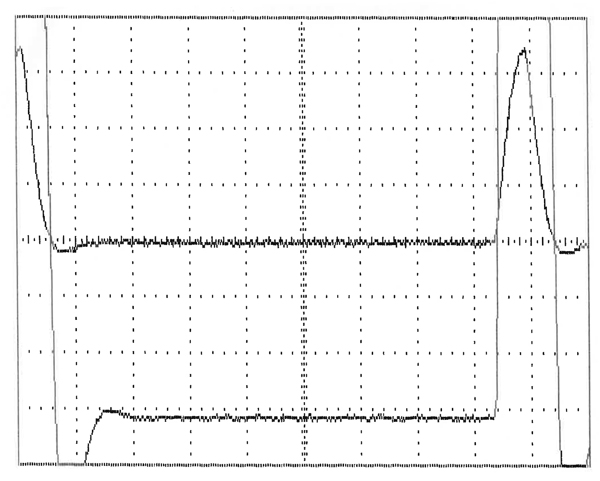
If these echoes do exist, then this measurement indicates they would have to be 64dB or more down from the level of the pulse; ie, at or below the LSB level in the lower trace, which is 4mV.
Fig.2 shows the same traces for the Lindsay-Geyer cable. With the exception of the slightly lower level of noise, they are identical to those in fig.1, with no echoes discernible. Fig.3 shows the same traces for the AudioQuest Lapis. A shielded design, this picks up less noise than the other two cables, but apart from that, again the traces are identical.
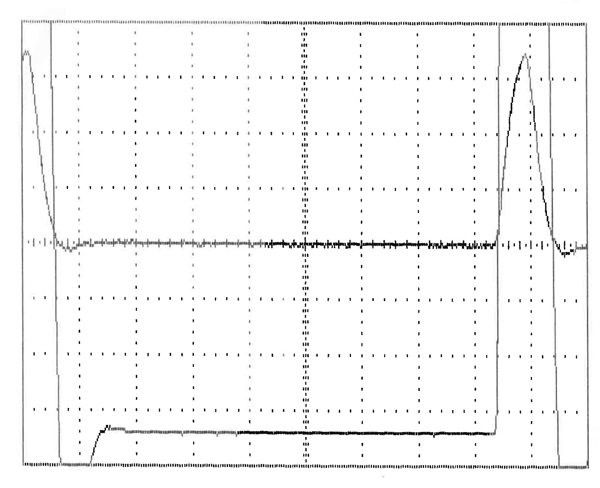
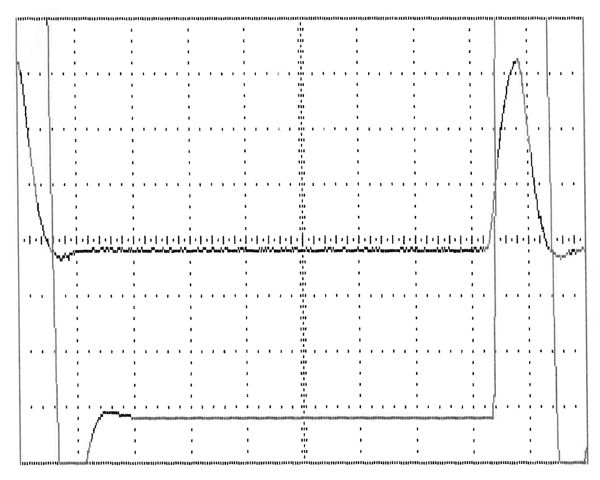
What if this pulse is too short to generate a visible L-G effect, its wideband frequency content resulting in any echo being smeared too much in time? I therefore set up a second series of tests with a longer pulse, approximately 240µs in length and of 10.2V peak amplitude. Fig.4 shows both the complete pulse (top trace) and a 100x-magnified version of the pulse tail (bottom trace) with the solid-core copper cable, while fig.5 shows the same curves for the L-G cable. This time, just in case it was the averaging of multiple traces that was contributing to the lack of visibility of any echoes, I just captured one trace. But note that even if there appear to be artifacts in the pulse tail, I didn't find these to be repeatable.
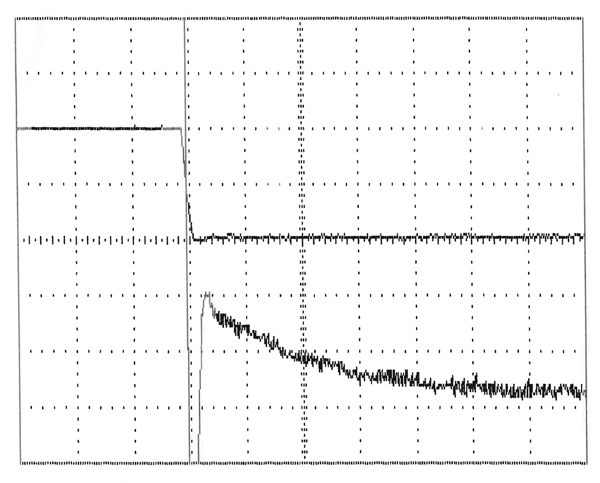
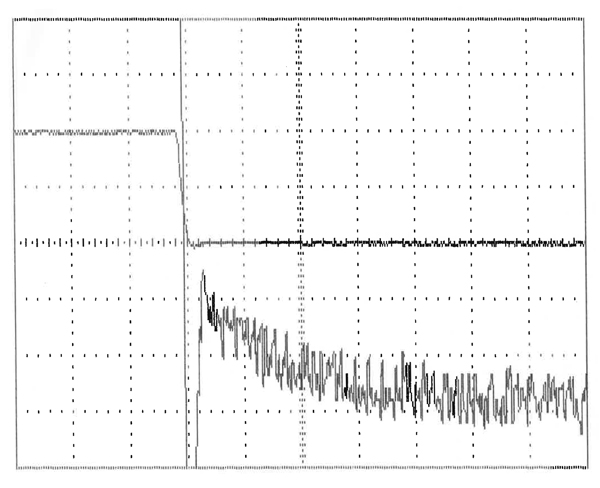
Note also that this time, the solid-core copper curves in fig.4 offer significantly less noise overall than the L-G curves in fig.5; DO did note in his review that the L-G cable does seem to be prone to picking up RF noise. Again, there are no obvious echoes. If there are any such echoes in the magnified solid-core copper trace, they would be buried in the noise, which has a peak amplitude of 4mV, some 68dB below the level of the pulse.
But, to be honest, we are digging around at the very limit of the measuring equipment's resolution here, and it is impossible to say what is real and what is a coincidental noise artifact. I would say that these results, while not disproving the Lindsay-Geyer hypothesis, indicate that any such transient smearing in conventional copper cable is going to be buried in the noise floor with any typical recording.
One point about all three cables used here strikes me, however. All are symmetrical in that the signal and ground are carried on identical conductors. Let us hypothesize that the Lindsay-Geyer effect exists, but that with symmetrical conductors, an equal but opposite echo will be produced in the ground conductor, this canceling that produced in the signal conductor. Isn't it then possible that the cable's symmetry is more important than whether or not the conductors are made from a permeable material? A final experiment suggested itself, therefore: to repeat the test with a physically asymmetrical RF coaxial cable, where this hypothetical, screen-generated anti-echo will not be opposite and identical to that produced by the central solid-core conductor.
Fig.6 shows the curves generated by the 'scope with the single unipolar pulse of 19µs duration and 7V peak amplitude applied to 5.1m of coax. (This cable has a 1.1mm-diameter solid-copper central conductor with four ground drain wires and a foil shield 4.5mm in diameter. The 5.1m length had a total measured capacitance of 330pF.) Comparison with figs.1, 2, and 3 shows no discernible difference. With the longer pulse (fig.7), it is apparent that the shielded cable picks up less RF noise, but the waveshape is fundamentally the same as in figs.4 and 5.

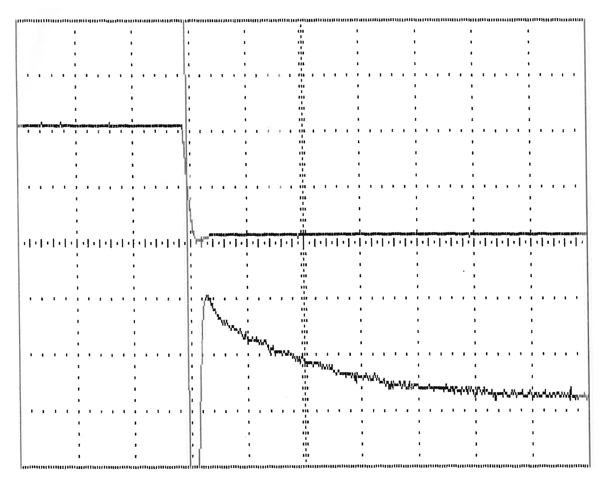
So, what to conclude? Evidence of effects which, if they occur, do so at the LSB level of a digital system, is hardly convincing. Further experiments with test equipment having a greater resolving power are planned, but if the Lindsay-Geyer effect is both so hard to find and so small if it does exist, can it really be subjectively important?—John Atkinson

Thanks for such an informative review. But is this cable brand still iin business since you mentioned the company is no longer in existance. Are they availabel for purchasing?

Couple things. One is that High Fidelity Cables also employ mu metal as conductor. As well as magnets in design of their cables. Two, drift velocity of electrons in a conductor is extremely slow, about a foot per hour, whereas the audio signal travels at a high percentage of the speed of light in a copper conductor due to the fact that the audio signal is comprised of photons. Photons are the only particles/waves capable of lightspeed in a vacuum, in fact they must travel at lightspeed as their speed is a constant. In a medium they travel at some large fraction of the speed of light. All electromagnetic waves are comprised of photons, everything from X-rays to radio waves to the audio signal.

Dear Sir,
While it is a fitting addition to your narrative, your comment that.
But it was later discovered that Eddington's results were fortuitous.
is incorrect.
This trope has been dealt with and put to rest as far back as 2007 with the final analysis showing that Eddington did not allow any personal bias to influence his results. This has been published in one of the more prestigious peer-reviewed journals — Nature; there has been no refutation since. It is now the accepted version of history and, is indeed taught as such in physics.
https://www.nature.com/news/2007/070910/full/news070903-20.html
While the trend to occasionally ignore scientific information is disturbing but is, however, par for the course, it is not befitting a publication such as this to promote information that is wrong. It would be much appreciated by the general readership if this error were corrected.
Respectfully,
T.S. Gnu

It appears to me that the author says "The experimental errors associated with his photographic plates were such that he could just as easily have obtained a negative result". At no time do I read that "personal bias" was the part of the message. I would interpret this as the experimental method used at that time was not as accurate as we may be able to do in this day and age. However, perhaps my interpretation of the author's writing/intent is incorrect, but I believe the words speak for themselves, bias intent is not mentioned.
Cheers,
Terry

You may perhaps read the article again if "at no time" you read what was pointed out in my post. In particular, you may find it useful to refer to:
The observer structures and interprets the data in accordance with his cognitive or theoretical framework. A scientist's preconceived notions, or theoretical view he is out to prove, will provide cues as to which data are essential or on how to pattern the data in order to support the theory.
A comment that the editor has, interestingly, now added a footnote to in an attempt to subtly establish grounds for argument from authority. I have, however, provided a peer reviewed reference rather than add my own substantial bonafides and degrees in physics.
Whilst I respect and admire the authors contributions to audio reporting, vague references to being "a physicist at Los Alamos" without more detailed background detract more than they add. My own work at present in JPL should not give me any more, or less, credibility. You may also have overlooked the line immediately following.
Thus, the data are imprinted with an unconscious subjective bias.
If "personal bias" were not part of the message, then the message ought not to be presaged by the aforementioned buildup. Also, while the author writes
The experimental errors associated with his photographic plates were such that he could just as easily have obtained a negative result.
And states that the results were "fortuitous," at no point is there mention of the fact the arrival at the (correct) conclusion was anything but fortuitous, although there is an implication to the contrary.
There is also a logical fallacy in the comment
The simplistic reduction of such an attitude leads to the following dictum: If it exists, it can be measured. The corollary of which is that if something cannot be measured, it does not exist
The corollary is a simplistic, and incorrect, reduction. The correct view is that if something cannot be measured, it is what Rumsfeld referred to as either a known unknown or an unknown unknown. Trotting out these convenient tropes to denigrate established scientific process is at best misguided, and at worst misleading, diminishing what we have accomplished as a species. This is the disturbing point that I addressed in my original post.
With respect to the questions
But how can you know a priori all of the factors which impact sonic performance? And at what level do these factors make an audible difference?
We don't. Possibly lower than (or in a different arena to) what we measure. I agree with the author on the existence of the gaps. I do not think that an agendum undermining Eddington's work (and scientific approaches in general) is necessary to make the point. I would say that this approach, in the authors words.lacks imagination" and lowers the tone of discussion.
Since English is not my first language, the effort to write a short post instead of a long one is a bit higher than the effort it would take a reader to peruse the long post. I would like to express my gratitude, in advance, for the readers indulgence to that effect.
Respectfully,
T.S. Gnu

A comment that the editor has, interestingly, now added a footnote to in an attempt to subtly establish grounds for argument from authority.
"Now"? This footnote was published as part of the original 1991 review and has always been included in this website reprint.
John Atkinson
Editor, Stereophile

" This trope has been dealt with and put to rest as far back as 2007" etc.
You do appreciate that this article is dated February 1991 ? I doubt that Dick Olsher had the ability to foresee the orthodox opinion of 16 years in the future.

I trust you do appreciate that the column was posted in this space on the web in 2018 without correction or comment from the editor. While Olsher didn't have the luxury of foresight, Atkinson does have the luxury of hindsight. A magazine website and editor do have the obligation of presenting facts as they are at the time of online publication if they devote space to an article published online at the time of online, you would agree? Else it is merely propagating falsehoods.
With respect to your comment title, it's not the problem with time, but the problem with the space devoted to propagating an (in retrospect) incorrect, or perhaps ill-represented, view. I hope you understand that this may be viewed as a particularly vexing problem especially when considering the image heading the article
Regards,
T.S. Gnu

In many cases it's best to read history without attaching commentary, unless there is a clear danger of accepting facts that have been proven false in the years since. I don't see such a danger here, because the article lays out the areas of investigation clearly, and the date is prominently noted at the top.

Ah yes the old, "I don't see a danger, therefore there is no danger" premise. Makes it a bit easy to be caught out by the existence of known and unknown unknowns there. Thanks for the insight and example, though.

The actual danger is in propagating falsehoods, as you said. But who is propagating those falsehoods? I suggest it's persons who we don't know who they are.

As mentioned, your support for Messrs Dunning and Kruger is well received.

This was all very interesting until I hit this:
'We all know that EM signals propagate at the speed of light—but that's true only in a vacuum. In copper at 1kHz, the signal speed is a relatively pedestrian 13 meters per second."
Do you really believe that signals propagate through a copper wire at ~29 miles per hour?

Do you really believe that signals propagate through a copper wire at ~29 miles per hour?
Please remember that the audio signal actually travels in the dielectric surrounding the conductor, penetrating the conductor in a frequency-dependent manner. See www.stereophile.com/reference/1095cable/index.html.
John Atkinson
Editor, Stereophile

You seem to be confused regarding signals, electromagnetic fields, maybe electron drift, and dialectrics.
A "signal", audio or not, will travel along a copper conductor at about 60% of the speed of light 'in vacuo', due to copper having a higher density than a vacuum, which of course doesn't have a density. Say 100,000 miles per second, NOT 29 miles per hour.
You don't agree? Think about this. The signal will still travel along the copper wire at that speed even if there is no dialectric at all, such as a bare copper wire in space.
Thus your "the signal actually travels in the dialectric" is wrong - what happens in the dialectric (if any, as above) is merely a side effect of the signal travelling in the copper conductor.

Unsurprisingly, your question has not been given a direct yes or no answer. Possible reasons would include an inability to differentiate between propagation velocity, Fermi velocity, and drift velocity amongst a myriad others. Confusion leads to some interesting conclusions, some of which best ought not to leap to without the aid of a parachute.
The number quoted is correct for A velocity; just not signal velocity, because that, as Pauli once said is not...even...wrong.

Thank you for the reference, John.
About a third of the way down the second page, the author gives an expression for propagation velocity. Unfortunately, the expression given is for “phase velocity” which is a different quantity altogether. True propagation velocity or group velocity has no frequency dependency. The frequency dependent effect you mention is that of attenuation.

if the signal hadn't already passed through 100 meters of typical cables before it got to its final place on the recording. We need a term to quantify cable distortion that is likely on the recording itself. How about Belden Meters. If the average recording has 100 BMs worth of distortion, can we really expect to hear an appreciable difference if we decrease the interconnect distortion from 1 BM to 0.15 BMs? I'm skeptical.

One wonders whether MQA might help with this blurring

If we accept a recording as a done deal, to possibly be superceded by a remaster years hence, then the question becomes "Does my cable make a difference, and is the difference positive on most of my recordings?" Or I could phrase it as "Is there a cable that sounds neutral on the vast majority of my recordings?" The problem with changing any component is being certain of a neutral or positive effect, which is not just a boosted treble or agreeable distortion that "sounds better". If I were putting together a new system or adding new speakers, I wouldn't bet the farm on a cable choice made within the first few days.

This article dead on! Have gone through many cables over 20+ years, and always go back to the L-G. Modified the connectors with copper Eichmann Bullet RCA plugs (plastic connector housings)). Yes, ground loop needs to be managed at times. When accomplished, they are simply the best. Have compared them to Nordost, Analysis Plus, Shindo, and many others. Nothing comes close. Mine are .5 meter long. Not always good as they are ultra revealing. Ruthlessly will reveal weaknesses in your system or the recording. Keeping this set. Longest lasting component I have owned.

This old article but brings up some ongoing issues in high end audio writing.
It is typical of the “Science is great and all...BUT!...” article. Lip service is paid briefly
to the scientific enterprise - “it’s not like you have to be a flat earther to be an audiophile” - and then this is used to launch into some version of “science doesn’t know everything” where
enough suspicion is cast on the limits or problems in science to give space for whatever dubious
report you are about to read.
Mr. Olsher starts out sounding like a skeptic, dismissive of “pseudoscientific technobabble” right up
to when he “tests” the claims of the cable maker. Then he relies on putting the cables in his system and listening with nary a thought about controlling for the effects of his imagination.
The same story seems to run through the manufacturer’s claims. It all sound “sciencey” right up until one asks for actual scientific methods of confirmation. David Lindsay
had essentially proposed a hypothesis based (it seems) on known measurable phenomena. Yet we see nothing in this report about the measured results from Lindsay showing at least he can measurably produce (or reduce) the effects he claims. That would be step one in Lindsay supporting his hypothesis. It would also include letting others know how to reproduce the measurements. Yet no measurements are given and John A was left to his own devices to figuring out how to test Lindsay’s claim. Sure enough, John could not confirm Lindsay’s claims via measurements.
But of course the reviewer “heard” this mysterious effect nonetheless, using only his own subjective impressions which are miraculously immune to all the known bias effects.
And so it goes, to this day, in high end audio reviewing. When there is no objective confirmation, well, too bad for science, my ears don’t lie!
I don’t think the article is “dedicated to the skeptics” as Olsher claimed so much as to the audiophile choir.
(Being an Audiophile and long time Stereophile reader I’m one of the choir, but this article certainly didn’t speak to the skeptic in me)

But of course the reviewer “heard” this mysterious effect nonetheless, using only his own subjective impressions...
I am not surprised that the reviewer felt the L-G magnetic cables sounded different from conventional cables. How could they not? And it is always possible that in the context of specific system, that difference is perceived to be an improvement.
See, for example, the case of single-ended triode amplifiers, which can give large frequency response changes, depending on the loudspeaker's impedance curve, and can introduce significant amounts of second-harmonic distortion. As I wrote back in 1995 in a Cary review, these amplifiers are actually tone controls, and no-one would argue that a tone control won't have audible results.
John Atkinson
Editor, Stereophile

“How could they not?”
I’m not sure. I looked at your measurement section which seemed to suggest
capacitance effects of this cable (eg high frequency roll off) would only come in to play
in certain systems. Did your measreuments determine that the LG cables would have
likely audible variation in Olsher’s system? These things would be nice to know for audiophiles
trying to sift manufacturer and reviewers claims from the variables (I.e. if the sonic change Olsher
heard was more likely due to capacitance attenuation than the phenomenon claimed by the
manufacturer, that’s obviously relevant insight to gain).
I certainly did appreciate your efforts to evaluate the technical claims made for the cable.

Did your measurements determine that the LG cables would have likely audible variation in Olsher’s system?
I am afraid I can't recall what components Dick Olsher was using when he prepared this review at the end of 1990, and contrary to Stereophile's policy, other than the power amplifier and speakers, he didn't say what products he used in the evaluation.
But the high capacitance may have been a factor, as was the tendency of the cable to pick up noise and hum. And I would not be surprised if the cable increased the level of non-linear distortion. But 27 years after the review was first published, I can only offer conjecture.
John Atkinson
Editor, Stereophile

It didn't prevent him writing pseudo-scientific technobabble, the very thing he accuses others of.
What's more 'skin effect' doesn't happen at audio frequencies.
And if he thinks his page 1 comments are an accurate description of how 'science' works he's wrong.
Also his "Maxwell" comments don't demonstrate a thing. Light is both waves and 'corpuscular' as they called it in Maxwell's time.
He is wrong about Eddington too. He said he needed further results, and he got them, as T.S. Gnu's reference shows.
[flame deleted by John Atkinson]
After two pages of utter nonsense I didn't waste my time reading beyond page 2.

Hi.
Are you sure?
Apparently you only know your side of knowledge of 'skin effect'
May I suggest you to learn more about its the other side!
"Science is about the search for a hidden reality"
Lindsay-Geyer Highly Magnetic Cables
Review by Dick Olsher on May 08 2018 Stereophile.
Read this, pal:-
"History shows us clearly that science does NOT provide certainty. It does NOT provide proof. It only provides the consensus of experts, based on the organized accumulation & scrutiny of evidence."
written by Naomi Oreskes & Erik Conway in their book "Merchants of Doubt".
FYI, I believe I know wires & cables more than many many out there as I had been involved in the electrical power industries for over 2 dacades.
Listening is believing
Jack L.
Canada